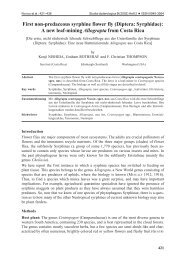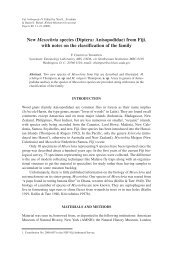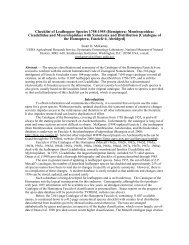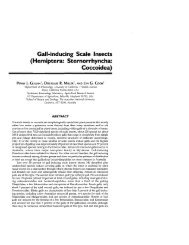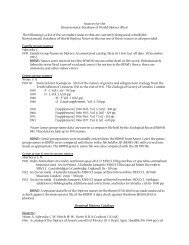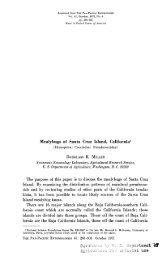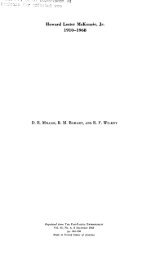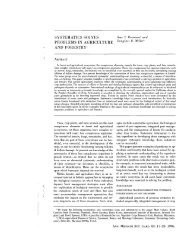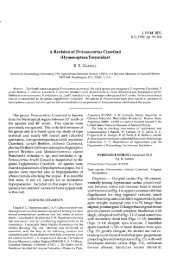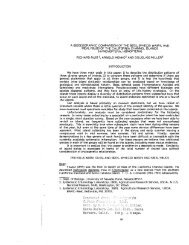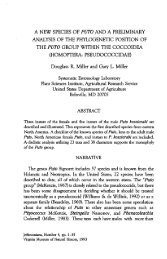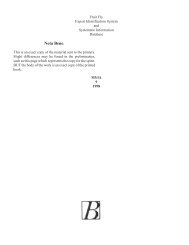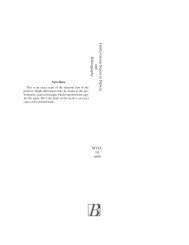Systematic revision of the Family Micrococcidae (Homoptera ...
Systematic revision of the Family Micrococcidae (Homoptera ...
Systematic revision of the Family Micrococcidae (Homoptera ...
You also want an ePaper? Increase the reach of your titles
YUMPU automatically turns print PDFs into web optimized ePapers that Google loves.
- 211 <br />
Anal lobes (plates) each with 3 (3 or 4) setae; longest seta 352 (260-424) fL<br />
long. Anal ring with 3 (8-11) pores on each half.<br />
Venter with small setae and 9 setae arranged in segmental lines, longest seta<br />
on abdomen, excluding marginal ones, 18 (14-23) fL long. Microtubular ducts<br />
present in 1 submarginal line on each side <strong>of</strong> body, with 2 ducts present on<br />
each segment. Discoidal pores in mediolateral and marginal areas <strong>of</strong> body,<br />
forming 2 pairs <strong>of</strong> indistinct longitudinal lines on each side <strong>of</strong> body.<br />
Intrastigmatic pores without central loculi, with 5-7 loculi, with 1 pore in<br />
each spiracle. Parastigmatic pores near each spiracle and near hind pair <strong>of</strong><br />
legs, without central loculi, with 5-9 loculi, with 9 (7-11) pores on each side <strong>of</strong><br />
body. Two specimens with 1 pore on 1 side <strong>of</strong> body between clusters near<br />
anterior and posterior spiracular clusters.<br />
Legs with hind femora each with 3 setae; tibiae with 3; tarsi with 4; tarsal<br />
digitule on hind 2 pairs <strong>of</strong> legs with acute or slightly swollen apices, front pair<br />
with 1 digitule small and filamentous and 1 digitule larger and slightly<br />
enlarged; claw digitules unequal in size, 1 with conspicuously swollen base and<br />
clubbed apex, 1 filamentous with acute or slightly swollen apex; femur 96 (84<br />
116) fL long; tibia 95 (79-126) fL long; tarsus 60 (52-69) fL long; femur length<br />
divided by tibia +tarsus length 0.6 (0.5-0.7). Antennae 130 (119-140) fL long;<br />
segments III and Veach with 1 conspicuously long seta, longest seta on segment<br />
V 210 (195-227) fL long.<br />
Notes - The description is based on 30 specimens from 3 localities.<br />
This material includes 6 specimens that are conspicuously larger than <strong>the</strong><br />
rest <strong>of</strong> <strong>the</strong> series. They have legs and antennae that are approximately <strong>the</strong> same<br />
size as those described above, and we suspect that <strong>the</strong>y are <strong>the</strong> form that aestivates<br />
during <strong>the</strong> dry season. These specimens are approximately 2 mID long and<br />
1 mm wide and differ from those described above by having <strong>the</strong> orifices <strong>of</strong> <strong>the</strong><br />
microtubular ducts, <strong>the</strong> parastigmatic pores, and <strong>the</strong> anal lobes much more<br />
heavily sclerotized.<br />
Adult male (Fig. IV)<br />
Recognition characters: Mounted, 1.9 (1.6-2.3) mm long, 0.7 (0.6-0.7) mm<br />
wide.<br />
Dorsum with filamentous setae arranged in 3 longitudinal lines on each side<br />
<strong>of</strong> abdomen, medial, mediolateral, and marginal; with 6 (6-8) setae on<br />
metathorax; longest seta on dorsomedial area <strong>of</strong> metathorax 17 (14-23) fL long,<br />
all setae in area about same length. Marginal setae usually about same length as<br />
rest <strong>of</strong> dorsum. Small bilocular pores uncommon, most prevalent near body



